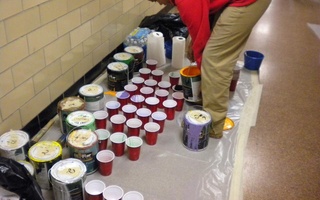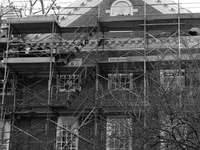“You really become a tight-knit community because you really have to walk by everybody at some point. You get caught in the elevator with them and end up catching up,” said Scott J. Yim ’13, a former Quincy House Committee Co-Chair.
Also crucial to these community building efforts are plans to construct common spaces in previously unused or inefficiently occupied rooms, such as those that once housed squash courts or now-obsolete machinery.
“There’s an amazing amount of space in these Houses, but it’s unusable,” said Bicknell.
For example, while all Houses have a Junior Common Room, these more formal spaces currently do not accommodate the many student organizations and other groups who need space around campus, according to Stephen Kieran, whose architecture firm KieranTimberlake designed the Old Quincy renovations.
“They didn’t have 700 student groups on campus in 1930,” he quipped.
Kieran’s plans for Quincy introduced what he described as “casual student life spaces,” including a large multipurpose room, music practice rooms, classrooms, and a terrace, which he envisions as a venue for everything from formal meetings to casual studying. Throughout the process, Kieran and administrators solicited student input on the designs through focus groups, surveys, and student involvement in the House Program Planning Committee. With more space specifically tailored to their needs, students will be able to convene and spend time together in ways they could not have before.
RIGHT TO PRIVACY
Despite the incorporation of additional common space into the renovation plans, some students said that their need for private space is being neglected.
For these students, the flip-side of the cluster community is the lack of a private common room—a place where they can hold social gatherings and parties on their own terms.
Yim, who toured a mock-up of a room in renovated Old Quincy last year, said he would not have wanted to live in a cluster community during his time as a Quincy resident without control over his common room.
During his sophomore year, Yim lived in a three-room triple in Old Quincy. Despite having to use the common room as a walk-through, Yim and his roommates liked the set-up.
“I loved the way that Old Quincy was laid out before. I liked having the option to choose whether or not you wanted to use it as a walk-through,” Yim said. “I think that versatility was great.”
Administrators seem to have a less clear vision of how students will be able to host social events with much less private space.
“And as far as partying, they always seem to find a party someplace,” said Quincy House Master Deborah J. Gehrke, when asked about the availability of party space when House renewal is complete. She specifically referenced rooms on the sixth floor of New Quincy, which are often host to parties on weekend nights.
“They love the sixth floor because they don’t have to get dressed,” she said. “Rain or shine, freezing degrees, they don’t have to go outside.”
Read more in College News
Learning From OccupyRecommended Articles
-
John F. Kennedy Slept Here; Soon You Will TooForget "Animal House." Residential life for Harvard first-years does not involve frat houses caked with years of party residue. Nor
-
 Harvard Graduate School of Education ‘GIVES’ Inspiration
Harvard Graduate School of Education ‘GIVES’ Inspiration -
 Housing Videos: Roundup Part Deux
Housing Videos: Roundup Part Deux -
Class of 2013 Chooses Class MarshalsNina M. Yancy '13 will head the 2013 Senior Class Committee as first class marshal, the Harvard Alumni Association and the Harvard College Fund announced on Monday.
-
 Robert X. Fogarty's 'Dear World' Photography Project Exhibits Harvard Members' Individuality
Robert X. Fogarty's 'Dear World' Photography Project Exhibits Harvard Members' Individuality -
 Walking Off: FM Investigates Athletes Who Opt-out of the Program
Walking Off: FM Investigates Athletes Who Opt-out of the Program














